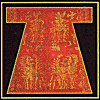Euripides' play adapted as a dance drama in Indonesian style, with songs in the original Greek, and English narration.
Music and dance were central to the performance of ancient Greek tragedy. And yet one would not believe so on the evidence of modern revivals. There are honourable exceptions, to be sure, but by far the majority of modern productions of ancient tragedies exclude music, and such choreography as there is is restricted to a few limp gestures of horror or supplication. Such an approach proceeds from, and helps to perpetuate, the widespread misconception that tragedy is meant to be a bleak and harrowing experience, a dry, nagging deception of elemental conflict.
But it was, in Euripides’ day, so much more than that: it was the main attraction in a patriotic and religious annual festival; a no-expense-spared celebration of the best the city could produce in the arts; a thrilling synthesis of speech, song, movement and spectacle. And the backbone was the singing and dancing chorus. Like the arias in an opera, or the numbers in a musical, the choral set-pieces were the high points of a tragedy—not just rest and relief from the plot,but virtually the raison d‘être of the whole enterprise. Indeed, in its earliest incarnation, tragedy was the chorus; and the use of speaking actors to represent characters in a story began, it appears, as a daring but limited experiment. And no matter how much the acting parts gained subsequently in importance, the chorus in Euripides’ day still had a central, life-affirming, part to play.
Our adaptation of Euripides’ Hippolytos is about reasserting the centrality of the ancient tragic chorus. To this end, all speaking parts have been removed; a narrator briefly recounts the unfolding of the plot at intervals; and the characters in the drama emerge mutely to act out their roles in mime and dance. All that remains intact of Euripides’ play is the lyrics of the choral set-pieces, performed in the original Greek, and some essentials of the plot. The challenge has been to demonstrate that, by working even within these parameters, it is possible to create a dramatic performance which is (for all the liberties we have taken) somehow truer to the spirit of ancient theatre than the bleak verbal dramas we have come to accept as the norm on the modern stage.
The music is new, and the choreography is new, for the simple reason that the originals are lost to us; and the information that we do possess about ancient music and dance in general is tantalising in its incompleteness. Authentic reconstruction would be an impossible task, and we have not attempted it. Instead, we have operated by analogy; and in turning for the choreography to the dance styles of Java, we were motivated not so much by a desire simply to experiment with merging cultures, as by a need to find a living, functioning dance-language which had some of the features crucial to our vision of the ancient art of dance: a coded, meaningful repertoire of stereotypical gestures, used to recreate stories from a legendary past. That the parallels between Indonesian and ancient Greek dramatic art may run deeper—for both feature performances taking place in a religious context, involving the enactment of myth through the use of speech, recitative, song, dancing, and masks—such parallels may or may not be significant. For our purposes, what has been decisive is the practical application: an elaborately coded dancing/acting style simply seems to work for Greek tragedy, in a way that other approaches do not; and this is enough to suggest that we are at least striking the right chords. |
|
